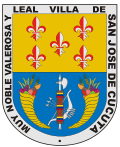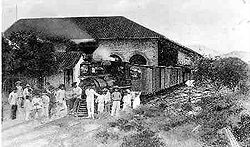Cúcuta
Cúcuta (pron. IPA koo`koo-tä), or San Jose de Cúcuta, is the capital of the Norte de Santander Department, in Colombia. Cúcuta is an important city in northeastern Colombia because of where it is; on the border with Venezuela. People from Cúcuta are called cucuteños.
City | |
|
| |
|
| |
 Map of Cúcuta in the Norte de Santander Department. Urban in red, municipality in dark gray | |
| Coordinates: 7°53′39″N 72°30′14″W / 7.89417°N 72.50389°WCoordinates: 7°53′39″N 72°30′14″W / 7.89417°N 72.50389°W | |
| Country | Colombia |
| Department | Norte de Santander |
| Foundation | June 17, 1733[1] |
| Government | |
| • Mayor | Maria Eugenia Riascos |
| Area | |
| • City | 1,176 km2 (454 sq mi) |
| Elevation | 325 m (1,066 ft) |
| Population (2005-2006 Census)[2] | |
| • City | 1,158,672 |
| • Density | 985.3/km2 (2,551.8/sq mi) |
| • Metro | 1,698,176 |
| Time zone | UTC-05 (Eastern Time Zone) |
| Website | www |
The area has grown fast since the 1960s, especially the suburbs of Villa del Rosario and Los Patios.
Adding also to the city's progress and development that had not been seen in 20 years with the building of six overpasses, a convention center, a new bus terminal, a new Integrated Massive Transportation System called Metrobus, the modernization of state owned schools, the recovery of Cucuta's downtown, and the duplication of the capacity for the General Santander Stadium. And the expectation over new industries that will come from Venezuela and will place their factories in Cucuta aimming at exporting through the Colombia Trade Promotion Agreement between Colombia and the United States.[3]
History
Simón Bolívar captured Cúcuta in 1813 and set out from there on his march to Caracas. At Cúcuta the constituent congress of 1821 met to draft the constitution of Greater Colombia (present day Venezuela, Ecuador and Colombia).
The city was largely destroyed by an earthquake on 18 May 1875, but was soon rebuilt.
In 1939, Cúcuta had 59,323 people. In 1990, it had 532,564. In 2005, the metropolitan area had 950,000 people.
Battle of Cúcuta
The Battle of Cúcuta was important for the moral importance that gave Bolivar advantages to release to Venezuela. The battle began at 9:00 AM of the 28 of February 1813 and finished at noon. There were 400 men in the control of Simón Bolivar and 800 under Spanish General Ramon Correa. Two dies and 14 hurt in the liberating troops and 20 dead and 40 hurt in the Spanish troops.
Earthquake of Cúcuta
Also known as the Earthquake of the Andes. It happened the May 18 of 1875 at 11:15 AM. It completely destroyed Cúcuta, Villa del Rosario, San Antonio del Tachira and Capacho also causing serious damage to the Venezuelan people in San Cristóbal, La Mulata, Rubio, Michelena, La Grita, and Colón, among others. It was felt in Bogota and Caracas.
Geography

Cúcuta is on a plateau in the Cordillera Oriental of the Colombian Andes.[4] The official metropolitan area includes the municipalities of: Villa del Rosario, Los Patios, El Zulia, and Puerto Santander. All four neighboring municipalities contain extensive rural areas despite recent urbanization.
Orography
The city of Cúcuta is plain toward the north and mountainous in its edges and in its central part, especially toward the south, where presents for the east the following mountains, removed of the eastern mountain range of the Colombian Andes.
Hydrography
Cúcuta and Norte de Santander have many rivers, none of them with pollution problems, being the Pamplonita River, the Guaramito River, the San Miguel River and the Zulia River de most important.[5]
Demography
Cúcuta is a city with a big demographic growth, because it had 387,481 people in 1951. It the 2005-2006 census, 1,158,672 people lived there.
Economy
Cúcuta has an agroindustry that mainly produces milk products and liquors, construction has boomed in recent years, but it's a net commercial city due to its condition of border city with Venezuela. Thanks to it the major Colombian commercial centers, banks, and warehouses have offices in the city.[6]
US - Colombia Free Trade Agreement implications for Cúcuta
Colombia signed a Free Trade Agreement with the United States to the opposition of Venezuela. Despite its opposition, industries from that country are constructing their infrastructure in Cúcuta to export their products to the United States, registering their products as if they were Colombian, an strategy that would allow them to export without paying certain tariffs. For that reason, Cúcuta is thought to become an industrial city.[3]
This process in individual, appears by the legal norm of Colombia that allows exemptions in taxes to make but competitive to the region (through the Zona Franca), in addition that the own geographic characteristics of the area at issue you appear greater possibilities of exporting products through position of Maracaibo (Venezuela).[7]
Shopping Malls
- Shopping Mall Unicentro
- Shopping Mall VENTURA Plaza (En construcción)
- Shopping Mall VIVERO
- Shopping Mall OITI
- Shopping Mall Plaza de Los Andes
- Shopping Mall Gran Boulevard
- Shopping Mall Bolívar
Climatology and Surface
Cúcuta has a municipal area of 1176 km² and is at 302 feet above sea level. The average temperature of 28 °C (82.4 °F) with an average humidity of 65%. Its medium annual precipitation is of 1,041mm. There are two rain seasons, between March-May and September-November. The dry months of the year are December and January with a medium precipitation of 58mm.[8]
The City
Cúcuta is also known as the "Ciudad sin fronteras" (City without borders), "La ciudad de los arboles" (The city of the trees), "La hermosa villa" (The beautiful ville), y "Ciudad verde" (Green city)
The city is served by one transportation terminal and the Camilo Daza Airport, which is north of the city. In general, the more prosperous areas are along and above west (Caobos, La Riviera and some places of the center) and to the east.
The state owned university, the Francisco de Paula Santander University (UFPS), is in the northeastern part of the city; there are several private universities of varying quality.
People
Many important personalities from Colombia are from Cúcuta such as the first President of Colombia, Francisco de Paula Santander, known as the man of the laws and Fabiola Zuluaga, tennis player,[9] Virgilio Barco, a former president of Colombia, Marino Vargas Villalta, businessman; his grandson, Juan Jose Germán Vargas, tennis player and the musician Elias M. Soto.
Monuments and Parks
Main monuments
- The monument of the Battle of Cúcuta
- The monument of Juana Rangel de Cuellar, the founder of Cúcuta
- The monument of Camilo Daza, in the Camilo Daza International Airport.
Main parks
- Santander Park (in Spanish "Parque Santander"). It is the main park of the city and is in front of the city hall.
- Colón Park (in Spanish "Parque Colón"). Constructed in honor to Christopher Columbus (in Spanish "Cristobal Colón").
- Simón Bolivar Park (in Spanish "Parque Simón Bolivar). constructed in honor to Simón Bolivar and donated by the Consulate of Venezuela in Cúcuta.
Green City
The generation of cucuteños (people from Cúcuta) and the legion of foreigners who reconstructed the city after the 1875 earthquake planted trees which grew fruits called clemones that had acid and bitter fruits with which the boys played.
Soon they were replaced by acacias, peracos and almonds tree. In the historical course of the arborization of the city, different stages as far as the spices have been marked that have been used in the ornamentación.
In Cúcuta the love for the trees is preached and applied, and cucuteño (people from Cúcuta) respect someone who has planted one in front of his house. For this reason Cúcuta is well-known like the city forest of Colombia.
Education
The basic education and the high school education are in Colombian "Calendary A" for schools (from February to November).
Schools
- Colegio Salesiano
- Colegio Calasanz
- Colegio La Salle
- Colegio Santo Angel de la Guarda
- Colegio Santa Teresa
- Colegio Gimnasio Domingo Savio
- Gimnasio Los Almendros
- Colegio Carmen Teresiano.
Universities
- Universidad de Santander
- Universidad Libre de Colombia
- Universidad de Pamplona
- Universidad Simón Bolivar
- Universidad Antonio Nariño
- Universidad Francisco de Paula Santander
Cúcuta Media
References
- ↑ "Cities and towns foundations". Luis Ángel Arango Library. Archived from the original on 2019-01-07. Retrieved 2008-01-07.
- ↑ http://www.dane.gov.co/files/investigaciones/poblacion/series_proyecciones/Dptos/norte_sant.xls
- ↑ 3.0 3.1 Comite Empresarial: TLC Archived 2006-10-09 at the Wayback Machine (in Spanish) comiteempresarial.org Accessed 15 October 2006.
- ↑ Biblioteca Luis Angel Arango: Geografia Cucuta Archived 2010-08-18 at the Wayback Machine (in Spanish) lablaa.org Accessed 15 October 2006.
- ↑ Ministerio del Medio Ambiente: Colombia; Rio de Cucuta Archived 2003-05-11 at Archive.today (in Spanish) minambiente.gov.co Accessed 15 October 2006.
- ↑ Greatest Cities: Cucuta (in Spanish) greatestcicites.com Accessed 15 October 2006.
- ↑ ANDI: Asociacion Nacional de Industriales - Colombia Archived 2003-08-20 at the Wayback Machine (in Spanish) andi.com.co Accessed 15 October 2006.
- ↑ Instituto de Estudios Ambientales IDEAM: Temperatura Cucuta (in Spanish) ideam.gov.co Accessed 15 October 2006.
- ↑ Azapedia: Fabiola Zuluaga (in Spanish) asapedia.com Accessed 15 October 2006.
Other websites
- City Hall of Cúcuta Archived 2007-06-09 at the Wayback Machine








